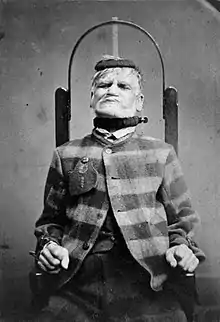Restraint chair
A restraint chair is a type of physical restraint that is used to force an individual to remain seated in one place to prevent injury and harm to themselves or others.[1] They are commonly used in prisons for violent inmates and hospitals for out of control patients. However, they have also been used to restrain prisoners at Guantanamo Bay detention camp during force-feeding.

In the United States, the use of these chairs is controversial because a number of deaths and injuries from prolonged periods have been reported. There have been numerous cases of financial settlements, as well as personal lawsuits and at least one class action suit.[2]
In Australia, the mere use of restraint chairs has sparked opposition.[3]
History

Various forms of restraint chair have been used for centuries. The modern, institutional type was introduced into the United States in the late 1990s.
Description
A typical, modern restraint chair consists of a sturdy frame, padded seat and padded reclining back, arm rests, a foot rest, and a set of back wheels. Straps secure the individual at the ankles, wrists, shoulders, and waist.
Organizations using restraint chairs
Restraint chairs are used in local jails as well as state and federal prisons.[4] They are used by the U.S. Marshals Service, the U.S. Immigration and Customs Enforcement and also in psychiatric hospitals and juvenile detention facilities.
Statistics
Numbers vary within the United States and across the world. An example of the number of times the chair was used is as follows:
- According to Jacksonville Sheriff's Office records, in 2015, the restraint chair was used 130 times, and then 137 times in 2014.[5]
- In Gwinnett County, during the first half of 2013, 129 inmates were held in a restraint chair.[2]
Hazards
A review of deaths at United States county jails revealed that there have been nearly 40 restraint chair-related deaths since the late 1990s.[4] Prolonged periods in a restraint chair can cause blood clots.
Incidents
There have been numerous incidents associated with the improper use of restraint chairs involving injury, torture, and death.[6]
- Cheatham County Jail officers were placed on leave after a 2017 video was released showing Jordan Norris being tased while restrained. One officer says on the video "I'll keep on doing that until I run out of batteries."[6][7][8] The victim has since filed a civil rights lawsuit in federal court.
- San Luis Obispo County was ordered to pay $5 million following the death of Andrew Holland who died after spending 46 hours in a restraining chair at the San Luis Obispo County Jail.[9]
- In July 2017, six Oklahoma officers were charged with manslaughter after Anthony Huff, a 58-year-old prisoner, died after spending over 48 hours in a restraining chair without enough food and water, and inadequate medical attention.[10]
- In March 2009, a Florida man was pepper sprayed multiple times then placed in a restraint chair in a Lee County jail. After being strapped in, a spit hood was placed over his head. He was then pepper sprayed twice more and left in the chair for a further six hours. He died in the hospital.[11]
- A video was released of two Georgia officers tasing a mentally ill man while he was restrained in a chair. 22-year-old Matthew Ajibade later died while in police custody.[12]
- The use of restraint chairs and spit hoods at the Don Dale Youth Detention Centre in the Northern Territory, Australia were part of the reason for the establishment of the Royal Commission into the Protection and Detention of Children in the Northern Territory.[13]
See also
- Medical restraint
- Spit hood, often used in conjunction
References
- "The Restraint Chair: Safe and Fun". Prison Legal News.
- Estep, Tyler. "Class action suit challenging 'restraint chair' use at jail".
- Davidson, Helen (26 July 2016). "The story of the chair: how a brutal device was brought into Australia's youth jails" – via The Guardian.
- "Controversial restraint chair linked to jail deaths".
- Minor, Tarik (13 September 2016). "How often does JSO use restraint chair for inmates?".
- "Tennessee: Video Shows Officers Tasering Teen in Restraint Chair".
- "Deputies accused of stunning man more than 40 times on leave".
- "Cheatham Jail Officers On Leave After Man Restrained, Tased". 28 July 2017.
- "SLO County to pay $5 million settlement for inmate's death after 46 hours in restraint chair".
- "Oklahoma Sheriff Indicted After Prisoner Dies in Restraint Chair".
- Balko, Radley (11 January 2012). "Death In The Devil's Chair: Florida Man's Pepper Spray Death Raises Questions About Jail Abuse" – via Huff Post.
- "Video Shows Deputies Stun-Gunning Man in Restraint Chair".
- Hunter, Fergus (27 July 2016). "Malcolm Turnbull calls royal commission into youth abuse at Northern Territory's Don Dale detention centre". Sydney Morning Herald. Retrieved 28 July 2016.
External links
| Wikimedia Commons has media related to Restraint chairs. |
- Investigation of Restraint Device Use in Iowa’s County Jails
- Mogen Mogen
- Video of a teen being strapped into a restraint chair in Australia
